

Paw Paw (Asimina triloba) is a tropical looking native understory fruit tree with large green leaves and delicious fruits. Flowers are born on old wood in the early spring and the maroon color is common of flowers meant to attract flies for pollination. Foliage is up to 12 inches long and turns a brilliant yellow in autumn for a couple weeks before falling. If cross pollination occurs, delicious fruits are produced in small clusters. The texture is custard like and taste is a mix between banana, mango, and hint of pineapple. Fruit is very fragile upon ripening and will fall to the ground and splat or be quickly devoured by animals. It is suggested that you put fruit nets around the clusters of fruit or harvest a few days earlier and allow to ripen inside. Fruit is rarely commercially available due to its fragility and short shelf-life. Cleaned fruit may be peeled frozen with seed intact: they can be picked out much easier when thawed out again Paw Paw may be eaten fresh, baked into desserts, or made into ice cream. Paw Paw is native to a large geographical area over eastern United States including Kansas. In the wild, Paw Paw grows in moist rich forest valleys in full to part shade. Best fruiting specimens can also be found on the edge of woodland or clearing in rich soil. Paw Paw tree colonies slowly spread by rhizomes and seem to occupy the forest understory sometimes for decades or centuries waiting for an opening to allow sunlight in. If a large canopy tree (such as an oak) dies or wind storm rolls through clearing a patch, new sunlight and an opening in the canopy occurs paving the way for sexual reproduction to take place (fruits) Paw Paw is somewhat tolerant of poorly drained soil's including clay but growth will be much slower. Interestingly, Paw Paws will tolerate and even need full sun when older to produce fruit. However, young saplings will quickly die in full sun from leaf burn and drought stress. If a tree is at least 4 to 6 tall and is planted in rich soil and full sun with regular irrigation, it will probably be fine. With these growing conditions, trees may grow at a median growth rate instead of slow, putting up 1 to 2 feet of new growth per year. If you have the right conditions for a Paw Paw tree, it should definitely be a part of your landscape whether you are growing for fruit production or not. There are dozens on improved cultivars available now days. In our Lawrence, KS display gardens, we are trialing several of these improved fruiting cultivars from Forrest Keeling Nursery in Missouri. Asimina triloba 'Pennsylvania Gold' produces good crop of medium to large fruits with sweet, flavorful flesh. It is one of the earliest ripening varieties.
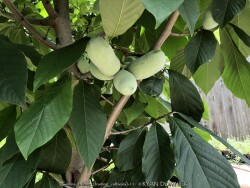

Paw Paw (Asimina triloba) is a tropical looking native understory fruit tree with large green leaves and delicious fruits. Flowers are born on old wood in the early spring and the maroon color is common of flowers meant to attract flies for pollination. Foliage is up to 12 inches long and turns a brilliant yellow in autumn for a couple weeks before falling. If cross pollination occurs, delicious fruits are produced in small clusters. The texture is custard like and taste is a mix between banana, mango, and hint of pineapple. Fruit is very fragile upon ripening and will fall to the ground and splat or be quickly devoured by animals. It is suggested that you put fruit nets around the clusters of fruit or harvest a few days earlier and allow to ripen inside. Fruit is rarely commercially available due to its fragility and short shelf-life. Cleaned fruit may be peeled frozen with seed intact: they can be picked out much easier when thawed out again Paw Paw may be eaten fresh, baked into desserts, or made into ice cream. Paw Paw is native to a large geographical area over eastern United States including Kansas. In the wild, Paw Paw grows in moist rich forest valleys in full to part shade. Best fruiting specimens can also be found on the edge of woodland or clearing in rich soil. Paw Paw tree colonies slowly spread by rhizomes and seem to occupy the forest understory sometimes for decades or centuries waiting for an opening to allow sunlight in. If a large canopy tree (such as an oak) dies or wind storm rolls through clearing a patch, new sunlight and an opening in the canopy occurs paving the way for sexual reproduction to take place (fruits) Paw Paw is somewhat tolerant of poorly drained soil's including clay but growth will be much slower. Interestingly, Paw Paws will tolerate and even need full sun when older to produce fruit. However, young saplings will quickly die in full sun from leaf burn and drought stress. If a tree is at least 4 to 6 tall and is planted in rich soil and full sun with regular irrigation, it will probably be fine. With these growing conditions, trees may grow at a median growth rate instead of slow, putting up 1 to 2 feet of new growth per year. If you have the right conditions for a Paw Paw tree, it should definitely be a part of your landscape whether you are growing for fruit production or not. There are dozens on improved cultivars available now days. In our Lawrence, KS display gardens, we are trialing several of these improved fruiting cultivars from Forrest Keeling Nursery in Missouri. Asimina triloba 'Potomac' has large, fleshy fruits with sweet, rich flavor and firm, smooth texture. This tree has a more upright habit that other pawpaw varieties.
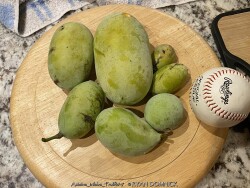

Paw Paw (Asimina triloba) is a tropical looking native understory fruit tree with large green leaves and delicious fruits. Flowers are born on old wood in the early spring and the maroon color is common of flowers meant to attract flies for pollination. Foliage is up to 12 inches long and turns a brilliant yellow in autumn for a couple weeks before falling. If cross pollination occurs, delicious fruits are produced in small clusters. The texture is custard like and taste is a mix between banana, mango, and hint of pineapple. Fruit is very fragile upon ripening and will fall to the ground and splat or be quickly devoured by animals. It is suggested that you put fruit nets around the clusters of fruit or harvest a few days earlier and allow to ripen inside. Fruit is rarely commercially available due to its fragility and short shelf-life. Cleaned fruit may be peeled frozen with seed intact: they can be picked out much easier when thawed out again Paw Paw may be eaten fresh, baked into desserts, or made into ice cream. Paw Paw is native to a large geographical area over eastern United States including Kansas. In the wild, Paw Paw grows in moist rich forest valleys in full to part shade. Best fruiting specimens can also be found on the edge of woodland or clearing in rich soil. Paw Paw tree colonies slowly spread by rhizomes and seem to occupy the forest understory sometimes for decades or centuries waiting for an opening to allow sunlight in. If a large canopy tree (such as an oak) dies or wind storm rolls through clearing a patch, new sunlight and an opening in the canopy occurs paving the way for sexual reproduction to take place (fruits) Paw Paw is somewhat tolerant of poorly drained soil's including clay but growth will be much slower. Interestingly, Paw Paws will tolerate and even need full sun when older to produce fruit. However, young saplings will quickly die in full sun from leaf burn and drought stress. If a tree is at least 4 to 6 tall and is planted in rich soil and full sun with regular irrigation, it will probably be fine. With these growing conditions, trees may grow at a median growth rate instead of slow, putting up 1 to 2 feet of new growth per year. If you have the right conditions for a Paw Paw tree, it should definitely be a part of your landscape whether you are growing for fruit production or not. There are dozens on improved cultivars available now days. In our Lawrence, KS display gardens, we are trialing several of these improved fruiting cultivars from Forrest Keeling Nursery in Missouri. Asimina triloba 'Prolific' can be grown as a multi-stemmed shrub or small tree. Great plant for attracting all kinds of wildlife. This is a heavy bearing variety with large, delicious, earlyripening fruit.
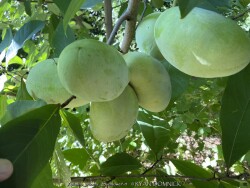

Paw Paw (Asimina triloba) is a tropical looking native understory fruit tree with large green leaves and delicious fruits. Flowers are born on old wood in the early spring and the maroon color is common of flowers meant to attract flies for pollination. Foliage is up to 12 inches long and turns a brilliant yellow in autumn for a couple weeks before falling. If cross pollination occurs, delicious fruits are produced in small clusters. The texture is custard like and taste is a mix between banana, mango, and hint of pineapple. Fruit is very fragile upon ripening and will fall to the ground and splat or be quickly devoured by animals. It is suggested that you put fruit nets around the clusters of fruit or harvest a few days earlier and allow to ripen inside. Fruit is rarely commercially available due to its fragility and short shelf-life. Cleaned fruit may be peeled frozen with seed intact: they can be picked out much easier when thawed out again Paw Paw may be eaten fresh, baked into desserts, or made into ice cream. Paw Paw is native to a large geographical area over eastern United States including Kansas. In the wild, Paw Paw grows in moist rich forest valleys in full to part shade. Best fruiting specimens can also be found on the edge of woodland or clearing in rich soil. Paw Paw tree colonies slowly spread by rhizomes and seem to occupy the forest understory sometimes for decades or centuries waiting for an opening to allow sunlight in. If a large canopy tree (such as an oak) dies or wind storm rolls through clearing a patch, new sunlight and an opening in the canopy occurs paving the way for sexual reproduction to take place (fruits) Paw Paw is somewhat tolerant of poorly drained soil's including clay but growth will be much slower. Interestingly, Paw Paws will tolerate and even need full sun when older to produce fruit. However, young saplings will quickly die in full sun from leaf burn and drought stress. If a tree is at least 4 to 6 tall and is planted in rich soil and full sun with regular irrigation, it will probably be fine. With these growing conditions, trees may grow at a median growth rate instead of slow, putting up 1 to 2 feet of new growth per year. If you have the right conditions for a Paw Paw tree, it should definitely be a part of your landscape whether you are growing for fruit production or not. There are dozens on improved cultivars available now days. In our Lawrence, KS display gardens, we are trialing several of these improved fruiting cultivars from Forrest Keeling Nursery in Missouri. Asimina triloba 'Sunflower' is a well-known, hardy selection originally from Chanute, Kansas. It ripens later than other varieties with large, flavorful fruit and is at lease partially self-fertile. Fruit has been described as tasting of mango, apricot, pineapple, banana and vanilla.


Paw Paw (Asimina triloba) is a tropical looking native understory fruit tree with large green leaves and delicious fruits. Flowers are born on old wood in the early spring and the maroon color is common of flowers meant to attract flies for pollination. Foliage is up to 12 inches long and turns a brilliant yellow in autumn for a couple weeks before falling. If cross pollination occurs, delicious fruits are produced in small clusters. The texture is custard like and taste is a mix between banana, mango, and hint of pineapple. Fruit is very fragile upon ripening and will fall to the ground and splat or be quickly devoured by animals. It is suggested that you put fruit nets around the clusters of fruit or harvest a few days earlier and allow to ripen inside. Fruit is rarely commercially available due to its fragility and short shelf-life. Cleaned fruit may be peeled frozen with seed intact: they can be picked out much easier when thawed out again Paw Paw may be eaten fresh, baked into desserts, or made into ice cream. Paw Paw is native to a large geographical area over eastern United States including Kansas. In the wild, Paw Paw grows in moist rich forest valleys in full to part shade. Best fruiting specimens can also be found on the edge of woodland or clearing in rich soil. Paw Paw tree colonies slowly spread by rhizomes and seem to occupy the forest understory sometimes for decades or centuries waiting for an opening to allow sunlight in. If a large canopy tree (such as an oak) dies or wind storm rolls through clearing a patch, new sunlight and an opening in the canopy occurs paving the way for sexual reproduction to take place (fruits) Paw Paw is somewhat tolerant of poorly drained soil's including clay but growth will be much slower. Interestingly, Paw Paws will tolerate and even need full sun when older to produce fruit. However, young saplings will quickly die in full sun from leaf burn and drought stress. If a tree is at least 4 to 6 tall and is planted in rich soil and full sun with regular irrigation, it will probably be fine. With these growing conditions, trees may grow at a median growth rate instead of slow, putting up 1 to 2 feet of new growth per year. If you have the right conditions for a Paw Paw tree, it should definitely be a part of your landscape whether you are growing for fruit production or not. There are dozens on improved cultivars available now days. In our Lawrence, KS display gardens, we are trialing several of these improved fruiting cultivars from Forrest Keeling Nursery in Missouri. Asimina triloba 'Wabash' features sweet fruit with medium firm flesh. It has excellent quality large-sized fruit with good productivity.


Paw Paw (Asimina triloba) is a tropical looking native understory fruit tree with large green leaves and delicious fruits. Flowers are born on old wood in the early spring and the maroon color is common of flowers meant to attract flies for pollination. Foliage is up to 12 inches long and turns a brilliant yellow in autumn for a couple weeks before falling. If cross pollination occurs, delicious fruits are produced in small clusters. The texture is custard like and taste is a mix between banana, mango, and hint of pineapple. Fruit is very fragile upon ripening and will fall to the ground and splat or be quickly devoured by animals. It is suggested that you put fruit nets around the clusters of fruit or harvest a few days earlier and allow to ripen inside. Fruit is rarely commercially available due to its fragility and short shelf-life. Cleaned fruit may be peeled frozen with seed intact: they can be picked out much easier when thawed out again Paw Paw may be eaten fresh, baked into desserts, or made into ice cream. Paw Paw is native to a large geographical area over eastern United States including Kansas. In the wild, Paw Paw grows in moist rich forest valleys in full to part shade. Best fruiting specimens can also be found on the edge of woodland or clearing in rich soil. Paw Paw tree colonies slowly spread by rhizomes and seem to occupy the forest understory sometimes for decades or centuries waiting for an opening to allow sunlight in. If a large canopy tree (such as an oak) dies or wind storm rolls through clearing a patch, new sunlight and an opening in the canopy occurs paving the way for sexual reproduction to take place (fruits) Paw Paw is somewhat tolerant of poorly drained soil's including clay but growth will be much slower. Interestingly, Paw Paws will tolerate and even need full sun when older to produce fruit. However, young saplings will quickly die in full sun from leaf burn and drought stress. If a tree is at least 4 to 6 tall and is planted in rich soil and full sun with regular irrigation, it will probably be fine. With these growing conditions, trees may grow at a median growth rate instead of slow, putting up 1 to 2 feet of new growth per year. If you have the right conditions for a Paw Paw tree, it should definitely be a part of your landscape whether you are growing for fruit production or not. There are dozens on improved cultivars available now days. In our Lawrence, KS display gardens, we are trialing several of these improved fruiting cultivars from Forrest Keeling Nursery in Missouri. Asimina triloba 'Wells' features large fruit up to one pound each have distinct banana-like flavor.
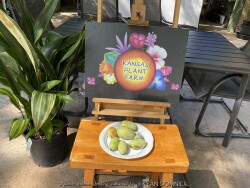

Paw Paw (Asimina triloba) is a tropical looking native understory fruit tree with large green leaves and delicious fruits. Flowers are born on old wood in the early spring and the maroon color is common of flowers meant to attract flies for pollination. Foliage is up to 12 inches long and turns a brilliant yellow in autumn for a couple weeks before falling. If cross pollination occurs, delicious fruits are produced in small clusters. The texture is custard like and taste is a mix between banana, mango, and hint of pineapple. Fruit is very fragile upon ripening and will fall to the ground and splat or be quickly devoured by animals. It is suggested that you put fruit nets around the clusters of fruit or harvest a few days earlier and allow to ripen inside. Fruit is rarely commercially available due to its fragility and short shelf-life. Cleaned fruit may be peeled frozen with seed intact: they can be picked out much easier when thawed out again Paw Paw may be eaten fresh, baked into desserts, or made into ice cream. Paw Paw is native to a large geographical area over eastern United States including Kansas. In the wild, Paw Paw grows in moist rich forest valleys in full to part shade. Best fruiting specimens can also be found on the edge of woodland or clearing in rich soil. Paw Paw tree colonies slowly spread by rhizomes and seem to occupy the forest understory sometimes for decades or centuries waiting for an opening to allow sunlight in. If a large canopy tree (such as an oak) dies or wind storm rolls through clearing a patch, new sunlight and an opening in the canopy occurs paving the way for sexual reproduction to take place (fruits) Paw Paw is somewhat tolerant of poorly drained soil's including clay but growth will be much slower. Interestingly, Paw Paws will tolerate and even need full sun when older to produce fruit. However, young saplings will quickly die in full sun from leaf burn and drought stress. If a tree is at least 4 to 6 tall and is planted in rich soil and full sun with regular irrigation, it will probably be fine. With these growing conditions, trees may grow at a median growth rate instead of slow, putting up 1 to 2 feet of new growth per year. If you have the right conditions for a Paw Paw tree, it should definitely be a part of your landscape whether you are growing for fruit production or not. There are dozens on improved cultivars available now days. In our Lawrence, KS display gardens, we are trialing several of these improved fruiting cultivars from Forrest Keeling Nursery in Missouri.
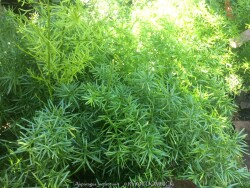

***Description for this plant available with future update!***
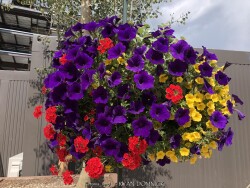

Assorted Annual Flowering Hanging Baskets offer intense color to the patio or pergola!


Annuals are planted for non-stop color to the garden or seasonal color beds!
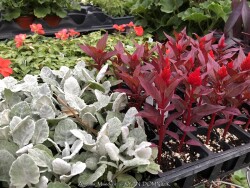

Annuals are planted for non-stop color to the garden or seasonal color beds!
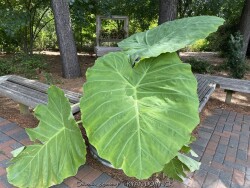

Annuals are planted for non-stop color to the garden or seasonal color beds!


Annuals are planted for non-stop color to the garden or seasonal color beds!


Succulents are usually spineless and grown for their beautiful shapes, color and texture. Cactus are known for their spines, unusual shapes and beautiful flowers. Late on the evolutionary timeline, cacti fossils are rare to non-existent. The "spines" are actually modified leaves! Cacti are native almost exclusively to the Americas, while succulents can include a much larger plant palette be from any dry area in the world. Both succulents and cacti store water in their fleshy tissues. They are usually grown as a patio or house plant in Kansas. In the wild, some species are hardy to below 0 degrees F. Grow in full sun with no extra watering except that which comes from rainfall. Repotting may or may not be needed depending on how large you want the plant to grow; plants can continue to grow taller and tolerate extremely root-bound pots but may need wind bracing. If repotting, make sure to use a sharp draining low organic cactus mix with plenty of sand and perlite. To play is safe, potted plants are best moved in before night temperatures get below 45 degrees F. It is important to avoid the combination of wet and cold. Move to a bright interior window over the winter with no watering and keep above freezing. As a winter house plant, it will look presentable all winter long with just no waterings. As a permanent house plant, provide bright light and allow the soil to dry between waterings for many years of carefree enjoyment. Plants grown permanently indoors may begin to elongate stretching for light and lose their spine color. It can be hard to reproduce the intense UV sunlight they need so moving outside for the summer is best. Generally if moving outside for the summer, allow 1-2 weeks of part shade or morning sun before placing in full sun. Plants with time to acclimate will thrive in full sun but be careful not to rush it or sunburning will occur. Potted plants are very low maintenance but watch for scale and mealybugs that may hide beneath the cover of spines.
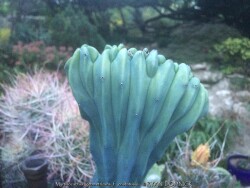

Succulents are usually spineless and grown for their beautiful shapes, color and texture. Cactus are known for their spines, unusual shapes and beautiful flowers. Late on the evolutionary timeline, cacti fossils are rare to non-existent. The "spines" are actually modified leaves! Cacti are native almost exclusively to the Americas, while succulents can include a much larger plant palette be from any dry area in the world. Both succulents and cacti store water in their fleshy tissues. They are usually grown as a patio or house plant in Kansas. In the wild, some species are hardy to below 0 degrees F. Grow in full sun with no extra watering except that which comes from rainfall. Repotting may or may not be needed depending on how large you want the plant to grow; plants can continue to grow taller and tolerate extremely root-bound pots but may need wind bracing. If repotting, make sure to use a sharp draining low organic cactus mix with plenty of sand and perlite. To play is safe, potted plants are best moved in before night temperatures get below 45 degrees F. It is important to avoid the combination of wet and cold. Move to a bright interior window over the winter with no watering and keep above freezing. As a winter house plant, it will look presentable all winter long with just no waterings. As a permanent house plant, provide bright light and allow the soil to dry between waterings for many years of carefree enjoyment. Plants grown permanently indoors may begin to elongate stretching for light and lose their spine color. It can be hard to reproduce the intense UV sunlight they need so moving outside for the summer is best. Generally if moving outside for the summer, allow 1-2 weeks of part shade or morning sun before placing in full sun. Plants with time to acclimate will thrive in full sun but be careful not to rush it or sunburning will occur. Potted plants are very low maintenance but watch for scale and mealybugs that may hide beneath the cover of spines.
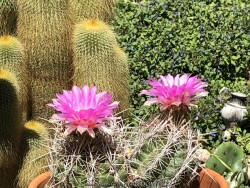

Succulents are usually spineless and grown for their beautiful shapes, color and texture. Cactus are known for their spines, unusual shapes and beautiful flowers. Late on the evolutionary timeline, cacti fossils are rare to non-existent. The "spines" are actually modified leaves! Cacti are native almost exclusively to the Americas, while succulents can include a much larger plant palette be from any dry area in the world. Both succulents and cacti store water in their fleshy tissues. They are usually grown as a patio or house plant in Kansas. In the wild, some species are hardy to below 0 degrees F. Grow in full sun with no extra watering except that which comes from rainfall. Repotting may or may not be needed depending on how large you want the plant to grow; plants can continue to grow taller and tolerate extremely root-bound pots but may need wind bracing. If repotting, make sure to use a sharp draining low organic cactus mix with plenty of sand and perlite. To play is safe, potted plants are best moved in before night temperatures get below 45 degrees F. It is important to avoid the combination of wet and cold. Move to a bright interior window over the winter with no watering and keep above freezing. As a winter house plant, it will look presentable all winter long with just no waterings. As a permanent house plant, provide bright light and allow the soil to dry between waterings for many years of carefree enjoyment. Plants grown permanently indoors may begin to elongate stretching for light and lose their spine color. It can be hard to reproduce the intense UV sunlight they need so moving outside for the summer is best. Generally if moving outside for the summer, allow 1-2 weeks of part shade or morning sun before placing in full sun. Plants with time to acclimate will thrive in full sun but be careful not to rush it or sunburning will occur. Potted plants are very low maintenance but watch for scale and mealybugs that may hide beneath the cover of spines.
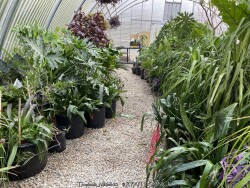

***Description for this plant available with future update!***


***Description for this plant available with future update!***
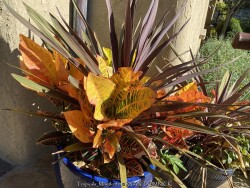

***Description for this plant available with future update!***
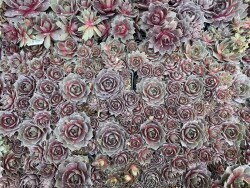

These tiny perennials and succulents produce various colored mats of foliage. In favorable conditions they can spread by runners rooting as they go; several species are valued in cultivation as groundcover for dry, sunny locations. Grow these in a rock garden, in cracks between rocks, or on top of or in a retaining wall. You may also grow in flat areas like in between stepping stones provided you used a gravelly or sandy base for the stones. Most rock garden plants will not tolerate rich moist soils as other plants or weeds will shade it out. Crown rot can occur during lengthy hot humid summer rainy periods. Most rock garden plants do not thrive indoors; aphids and spider mites seem to find them after a few months but overwintering indoors in a cool environment may work. If grown in pots and kept on the dry side, you may leave out all winter allowing to freeze solid; plants will go dormant and resume growth in the spring.
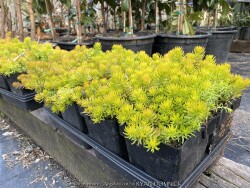

These tiny perennials and succulents produce various colored mats of foliage. In favorable conditions they can spread by runners rooting as they go; several species are valued in cultivation as groundcover for dry, sunny locations. Grow these in a rock garden, in cracks between rocks, or on top of or in a retaining wall. You may also grow in flat areas like in between stepping stones provided you used a gravelly or sandy base for the stones. Most rock garden plants will not tolerate rich moist soils as other plants or weeds will shade it out. Crown rot can occur during lengthy hot humid summer rainy periods. Most rock garden plants do not thrive indoors; aphids and spider mites seem to find them after a few months but overwintering indoors in a cool environment may work. If grown in pots and kept on the dry side, you may leave out all winter allowing to freeze solid; plants will go dormant and resume growth in the spring.


Succulents are usually spineless and grown for their beautiful shapes, color and texture. Cactus are known for their spines, unusual shapes and beautiful flowers. Late on the evolutionary timeline, cacti fossils are rare to non-existent. The "spines" are actually modified leaves! Cacti are native almost exclusively to the Americas, while succulents can include a much larger plant palette be from any dry area in the world. Both succulents and cacti store water in their fleshy tissues. They are usually grown as a patio or house plant in Kansas. In the wild, some species are hardy to below 0 degrees F. Grow in full sun with no extra watering except that which comes from rainfall. Repotting may or may not be needed depending on how large you want the plant to grow; plants can continue to grow taller and tolerate extremely root-bound pots but may need wind bracing. If repotting, make sure to use a sharp draining low organic cactus mix with plenty of sand and perlite. To play is safe, potted plants are best moved in before night temperatures get below 45 degrees F. It is important to avoid the combination of wet and cold. Move to a bright interior window over the winter with no watering and keep above freezing. As a winter house plant, it will look presentable all winter long with just no waterings. As a permanent house plant, provide bright light and allow the soil to dry between waterings for many years of carefree enjoyment. Plants grown permanently indoors may begin to elongate stretching for light and lose their spine color. It can be hard to reproduce the intense UV sunlight they need so moving outside for the summer is best. Generally if moving outside for the summer, allow 1-2 weeks of part shade or morning sun before placing in full sun. Plants with time to acclimate will thrive in full sun but be careful not to rush it or sunburning will occur. Potted plants are very low maintenance but watch for scale and mealybugs that may hide beneath the cover of spines. Some species grow well in hanging baskets!
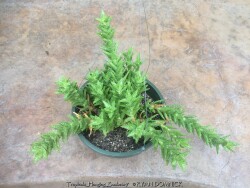

***Description for this plant available with future update!***
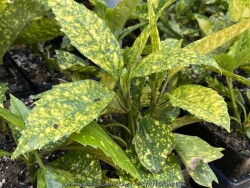

Japanese Aucuba (Aucuba japonica) is a surprisingly hardy evergreen shrub from Japan featuring dark green leaves with gold spots. Flowering and fruiting may occur in warmer climates but have not witnessed that in our zone 6a climate. Aucuba is at the northern edge of its range but will survive and reach varying heights of 1 to 3 feet. Winterkill occurs at about -5 to -10° so plan to prune off winter kill and new growth will resume in spring. In southern zones with mild winters aucuba can reach 6-8' tall, tolerating full shade and drought making it a great dry shade plant. In our Lawrence Gardens, this is possible if sited on a south exposure in full shade with winter wind protection. Rich organic soils and morning sun / filtered sun are both preferred in northern climates. Watering during the winter when dry will help broadleaf evergreen shrubs stay hydrated and maintain their winter foliage better. This jewel of the shade garden adds valuable bright green and yellow winter color giving some structure. Combine with other shade plants such as hosta, Solomon Seal, Hellebore, Barrenwort, or Coralberry. Plants in our Lawrence, KS gardens generally survive for several years and are worth the effort in the shade garden. Don't count on them getting very big so plant close together if designing with a grouping. Aucuba japonica 'Gold King' is a male form with numerous gold spots on dark green leaves.
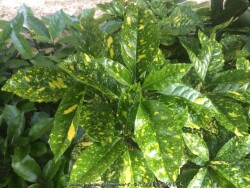

Japanese Aucuba (Aucuba japonica) is a surprisingly hardy evergreen shrub from Japan featuring dark green leaves with gold spots. Flowering and fruiting may occur in warmer climates but have not witnessed that in our zone 6a climate. Aucuba is at the northern edge of its range but will survive and reach varying heights of 1 to 3 feet. Winterkill occurs at about -5 to -10° so plan to prune off winter kill and new growth will resume in spring. In southern zones with mild winters aucuba can reach 6-8' tall, tolerating full shade and drought making it a great dry shade plant. In our Lawrence Gardens, this is possible if sited on a south exposure in full shade with winter wind protection. Rich organic soils and morning sun / filtered sun are both preferred in northern climates. Watering during the winter when dry will help broadleaf evergreen shrubs stay hydrated and maintain their winter foliage better. This jewel of the shade garden adds valuable bright green and yellow winter color giving some structure. Combine with other shade plants such as hosta, Solomon Seal, Hellebore, Barrenwort, or Coralberry. Plants in our Lawrence, KS gardens generally survive for several years and are worth the effort in the shade garden. Don't count on them getting very big so plant close together if designing with a grouping. Aucuba japonica 'Marmorata' is a female form with numerous gold blotches on dark green leaves.
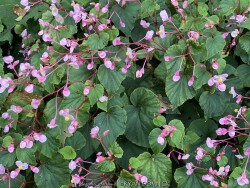

Hardy Begonia (Begonia grandis) is planted for its attractive green foliage with reddish stems along with its breathtaking summer/fall pink flower display. It is a tuberous-rooted, clump-forming perennial that typically forms a bushy mound of foliage to 2' tall on branching stems. Foliage maintains well all season provided that certain cultural conditions are met. Native to forests with humusy, medium to wet, well-drained soil in part shade to full shade, it needs constantly moist soil rich in organic matter but avoid clay. Good late summer flowering shade plant which mixes well with hostas and ferns in the shade garden. Tolerates heavy shade and black walnut trees. Generally this plant declines after a few years of Kansas climate if dealing with summer droughts but worth a try in rich organic soils in well-tended shade gardens. Where happy, plants can multiply quickly and flower continuously in summer. If low temperatures hit -10 degrees F, it may kill an un-mulched plant; protect any zone 6 perennial with thick layer of mulch. An large established grouping exists at OSU Botanical Gardens in Stillwater, OK. This grouping has proven hardy with 2-3" of mulch and lows down to -14 degrees F on Feb 16th, 2021. The longevity of this cold blast was also impressive: 12 days on a row with highs below 32 degrees F, 7 nights of lows in the single digits and negatives and 48-60 hours of 5 degrees F and mostly lower. A hard ground freeze was inevitable with no damage to tubers.
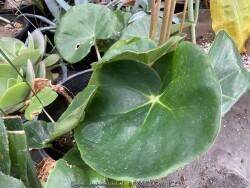

***Description for this plant available with future update!***
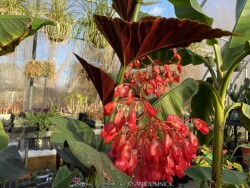

Angel Wing Begonia (Tropical), is also known as Begonia x coralline
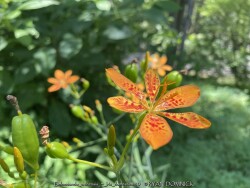

***Description for this perennial available with future update!***
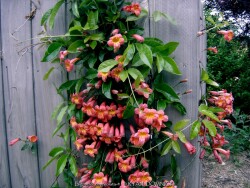

Crossvine (Bignonia capreolata) is a highly ornamented evergreen vine native to the southeast west to Oklahoma and Texas. Fantastic blooms completely cover the plant and occur on old wood in the late spring for about 3-5 weeks then sporadically during the summer. Flowers are trumpet-shaped, orange and red with yellow throats. Although in the same family as trumpet vine (campus radicans), crossvine is not invasive. Plant crossvine on fences or pergolas where you want good coverage but not anything sprawling too far away from the structure needing pruning. Considered to be one of the lowest maintenance of all vines. Crossvine prefer for part to full sun on in medium to rich soils and are able to tolerate drought and brief flooding once established. There are no serious pests or diseases to worry about. Crossvine has thrived in our Lawrence Kansas zone 6a display garden for over 15 years enduring a few occasions of -10° or colder winters. Winter foliage turns purple and remains evergreen till about -10. We have seen -18° without any dieback on the vine other than the loss of foliage that year. This great vine has it all, beautiful flowers, evergreen foliage, and constrained growth habit!
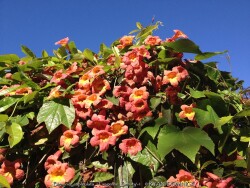

Crossvine (Bignonia capreolata) is a highly ornamented evergreen vine native to the southeast west to Oklahoma and Texas. Fantastic blooms completely cover the plant and occur on old wood in the late spring for about 3-5 weeks then sporadically during the summer. Flowers are trumpet-shaped, orange and red with yellow throats. Although in the same family as trumpet vine (campus radicans), crossvine is not invasive. Plant crossvine on fences or pergolas where you want good coverage but not anything sprawling too far away from the structure needing pruning. Considered to be one of the lowest maintenance of all vines. Crossvine prefer for part to full sun on in medium to rich soils and are able to tolerate drought and brief flooding once established. There are no serious pests or diseases to worry about. Crossvine has thrived in our Lawrence Kansas zone 6a display garden for over 15 years enduring a few occasions of -10° or colder winters. Winter foliage turns purple and remains evergreen till about -10. We have seen -18° without any dieback on the vine other than the loss of foliage that year. This great vine has it all, beautiful flowers, evergreen foliage, and constrained growth habit! Bignonia capreolata 'Tangerine Beauty' is noted for its tangerine flowers and slightly improved cold hardiness.
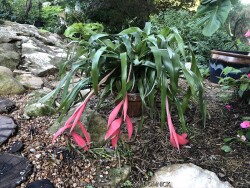

Billbergia Bromeliad / Friendship Plant (Tropical), is also known as Billbergia nutans
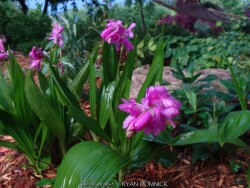

Hardy Ground Orchid (Bletilla striata) is planted for its attractive green foliage with and amazing spring flower display of pink and magenta "orchid-like" flowers. Foliage maintains well all season provided that certain cultural conditions are met. Native to Chinese forests with humusy, well-drained soil in part shade to full shade, it needs constantly moist to average soil rich in organic matter but avoid clay. If low temperatures hit -10 degrees F, it may kill an un-mulched plant; protect any zone 6 perennial with thick layer of mulch. I have occasionally seen entire plantings wiped out at -10 to15 degrees F with no mulch or snow cover. Good late summer flowering shade plant which mixes well with hostas and ferns in the shade garden. Generally this plant has declined after a few years in our Kansas display garden but worth a try in perfect soils in well-tended shade gardens.
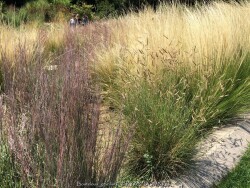

Blue Grama Grass (Bouteloua gracilis) is a long-lived, clump-forming, warm-season, perennial grass native to North America. It is one of the dominant grasses of the dry shortgrass prairies. Blue grama has very thin green to greyish leaves that turn golden brown in autumn, sometimes also developing interesting shades of orange. Purplish-tinged eyebrow-shaped flowers appear on arching stems above the foliage in early to mid-summer. Height before flowering is 12-15" increasing to 24" after flowering. As a native to the Great Plains, blue grama displays excellent drought tolerance but tolerates a wide range of soils. Avoid poorly-drained soils. In Eastern Kansas, typically our 40 inches of rainfall is sufficient without extra water. Occasionally suffering from excessive rainy spells and high humidity, foliage rust diseases can be a problem in shade or poor air circulation areas. To counteract that in Kansas, plant in full sun on berm with poor sandy, rocky, or clay soil with no irrigation. Blue grama grass works very well in an ornamental grass garden adding contrast, texture, and short stature. Use as mass plantings to create a drift that can be enjoyed from far away. For mass plantings, plant individual plants close together as they don't spread much. Dried foliage holds up very well in the winter offering a one-of-a-kind look. The only maintenance is to cut down or burn before new growth emerges. Combine with other flowering prairie native perennials for a long season of interest. Also useful as a full-sun turf grass for extremely dry or sandy soils or where buffalo grass doesn't work. It can be regularly mowed to 3-4" high.
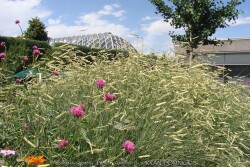

Blonde Ambition Blue Grama Grass (Bouteloua gracilis 'Blonde Ambition') is a long-lived, clump-forming, warm-season, perennial grass native to North America. It is one of the dominant grasses of the dry shortgrass prairies. Blue grama has very thin green to greyish leaves that turn golden brown in autumn, sometimes also developing interesting shades of orange. Chartreuse eyebrow-shaped flowers appear on arching stems above the foliage in early to mid-summer. Height before flowering is 12-18" increasing to 24-30" after flowering. The seed heads form a dense, compact, but airy look turning a bright blonde color in fall and winter. As a native to the Great Plains, blue grama displays excellent drought tolerance but tolerates a wide range of soils. Avoid poorly-drained soils. In Eastern Kansas, typically our 40 inches of rainfall is sufficient without extra water. Occasionally suffering from excessive rainy spells and high humidity, foliage rust diseases can be a problem in shade or poor air circulation areas. To counteract that in Kansas, plant in full sun on berm with poor sandy, rocky, or clay soil with no irrigation. Blue grama grass works very well in an ornamental grass garden adding contrast, texture, and short stature. Use as mass plantings to create a drift that can be enjoyed from far away. For mass plantings, plant individual plants close together as they don't spread much. Dried foliage holds up very well in the winter offering a one-of-a-kind look. The only maintenance is to cut down or burn before new growth emerges. Combine with other flowering prairie native perennials for a long season of interest. Also useful as a full-sun turf grass for extremely dry or sandy soils or where buffalo grass doesn't work. It can be regularly mowed to 3-4" high.


Brugmansia is a genus of seven species of flowering plants in the nightshade family Solanaceae from South America. It is typically grown in warmer zones as a shrub or tree but is extinct from the wild (only known in cultivation). Along with other tropicals and succulents in Kansas, Angel Trumpet Flower is usually grown as summer patio plant with amazing foot-long hanging flowers and sweet aroma. Water regularly and place in full sun or part shade. Protect from temperatures below 32 degrees F and move into a cold garage or basement over the winter with minimal watering. Do not allow the pot with rootball to freeze solid or go below 28 degrees for more than a few hours. Allow to go dormant as needed with little care, just cut off dead foliage/twigs and place back out in April or May with a time-release fertilizer. You may also propagate this plant easily by cutting off dormant twigs/branches and stuffing them into the ground. Notice that I didn't say rooting hormone or even being careful was necessary! Landscapers also plant these as an annual in the ground for an enormous tropical effect with fragrant flowers and growth reaching 5-8' in one season from a 1gal container! It is possible to overwinter Brugmansia in the ground in Kansas as a woody perennial. In our trial gardens in Lawrence, KS (zone 6a), a one year established specimen planted in our annual bed was mulched 12-18" thick with leaf mulch survived -10 degrees F. The dieback was deep into the ground but somehow came back from a piece of deep root. The leaf mulch was also well rotted and formed somewhat of an ice barrier insulating effect. Brugmansia species are amongst the most toxic of ornamental plants so do not eat and part of this plant! Brugmansia 'Charles Grimaldi' features orange flowers.
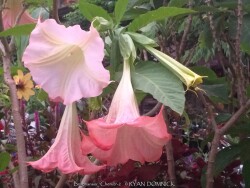

Brugmansia is a genus of seven species of flowering plants in the nightshade family Solanaceae from South America. It is typically grown in warmer zones as a shrub or tree but is extinct from the wild (only known in cultivation). Along with other tropicals and succulents in Kansas, Angel Trumpet Flower is usually grown as summer patio plant with amazing foot-long hanging flowers and sweet aroma. Water regularly and place in full sun or part shade. Protect from temperatures below 32 degrees F and move into a cold garage or basement over the winter with minimal watering. Do not allow the pot with rootball to freeze solid or go below 28 degrees for more than a few hours. Allow to go dormant as needed with little care, just cut off dead foliage/twigs and place back out in April or May with a time-release fertilizer. You may also propagate this plant easily by cutting off dormant twigs/branches and stuffing them into the ground. Notice that I didn't say rooting hormone or even being careful was necessary! Landscapers also plant these as an annual in the ground for an enormous tropical effect with fragrant flowers and growth reaching 5-8' in one season from a 1gal container! It is possible to overwinter Brugmansia in the ground in Kansas as a woody perennial. In our trial gardens in Lawrence, KS (zone 6a), a one year established specimen planted in our annual bed was mulched 12-18" thick with leaf mulch survived -10 degrees F. The dieback was deep into the ground but somehow came back from a piece of deep root. The leaf mulch was also well rotted and formed somewhat of an ice barrier insulating effect. Brugmansia species are amongst the most toxic of ornamental plants so do not eat and part of this plant! Brugmansia 'Cherub' features bright pink flowers.
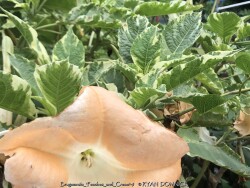

Brugmansia is a genus of seven species of flowering plants in the nightshade family Solanaceae from South America. It is typically grown in warmer zones as a shrub or tree but is extinct from the wild (only known in cultivation). Along with other tropicals and succulents in Kansas, Angel Trumpet Flower is usually grown as summer patio plant with amazing foot-long hanging flowers and sweet aroma. Water regularly and place in full sun or part shade. Protect from temperatures below 32 degrees F and move into a cold garage or basement over the winter with minimal watering. Do not allow the pot with rootball to freeze solid or go below 28 degrees for more than a few hours. Allow to go dormant as needed with little care, just cut off dead foliage/twigs and place back out in April or May with a time-release fertilizer. You may also propagate this plant easily by cutting off dormant twigs/branches and stuffing them into the ground. Notice that I didn't say rooting hormone or even being careful was necessary! Landscapers also plant these as an annual in the ground for an enormous tropical effect with fragrant flowers and growth reaching 5-8' in one season from a 1gal container! It is possible to overwinter Brugmansia in the ground in Kansas as a woody perennial. In our trial gardens in Lawrence, KS (zone 6a), a one year established specimen planted in our annual bed was mulched 12-18" thick with leaf mulch survived -10 degrees F. The dieback was deep into the ground but somehow came back from a piece of deep root. The leaf mulch was also well rotted and formed somewhat of an ice barrier insulating effect. Brugmansia species are amongst the most toxic of ornamental plants so do not eat and part of this plant! Brugmansia 'Peaches and Cream' features white and green variegated foliage and light orange flowers.
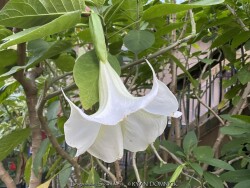

Brugmansia is a genus of seven species of flowering plants in the nightshade family Solanaceae from South America. It is typically grown in warmer zones as a shrub or tree but is extinct from the wild (only known in cultivation). Along with other tropicals and succulents in Kansas, Angel Trumpet Flower is usually grown as summer patio plant with amazing foot-long hanging flowers and sweet aroma. Water regularly and place in full sun or part shade. Protect from temperatures below 32 degrees F and move into a cold garage or basement over the winter with minimal watering. Do not allow the pot with rootball to freeze solid or go below 28 degrees for more than a few hours. Allow to go dormant as needed with little care, just cut off dead foliage/twigs and place back out in April or May with a time-release fertilizer. You may also propagate this plant easily by cutting off dormant twigs/branches and stuffing them into the ground. Notice that I didn't say rooting hormone or even being careful was necessary! Landscapers also plant these as an annual in the ground for an enormous tropical effect with fragrant flowers and growth reaching 5-8' in one season from a 1gal container! It is possible to overwinter Brugmansia in the ground in Kansas as a woody perennial. In our trial gardens in Lawrence, KS (zone 6a), a one year established specimen planted in our annual bed was mulched 12-18" thick with leaf mulch survived -10 degrees F. The dieback was deep into the ground but somehow came back from a piece of deep root. The leaf mulch was also well rotted and formed somewhat of an ice barrier insulating effect. Brugmansia species are amongst the most toxic of ornamental plants so do not eat and part of this plant! Brugmansia 'Snowflake' features pure white flowers. Our plant came from Brian's Botanicals in Kentucky.
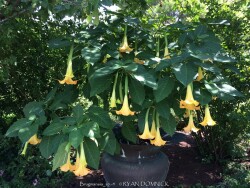

Brugmansia is a genus of seven species of flowering plants in the nightshade family Solanaceae from South America. It is typically grown in warmer zones as a shrub or tree but is extinct from the wild (only known in cultivation). Along with other tropicals and succulents in Kansas, Angel Trumpet Flower is usually grown as summer patio plant with amazing foot-long hanging flowers and sweet aroma. Water regularly and place in full sun or part shade. Protect from temperatures below 32 degrees F and move into a cold garage or basement over the winter with minimal watering. Do not allow the pot with rootball to freeze solid or go below 28 degrees for more than a few hours. Allow to go dormant as needed with little care, just cut off dead foliage/twigs and place back out in April or May with a time-release fertilizer. You may also propagate this plant easily by cutting off dormant twigs/branches and stuffing them into the ground. Notice that I didn't say rooting hormone or even being careful was necessary! Landscapers also plant these as an annual in the ground for an enormous tropical effect with fragrant flowers and growth reaching 5-8' in one season from a 1gal container! It is possible to overwinter Brugmansia in the ground in Kansas as a woody perennial. In our trial gardens in Lawrence, KS (zone 6a), a one year established specimen planted in our annual bed was mulched 12-18" thick with leaf mulch survived -10 degrees F. The dieback was deep into the ground but somehow came back from a piece of deep root. The leaf mulch was also well rotted and formed somewhat of an ice barrier insulating effect. Brugmansia species are amongst the most toxic of ornamental plants so do not eat and part of this plant! Flowers come in Orange, Red, Pink, and White.


Brugmansia is a genus of seven species of flowering plants in the nightshade family Solanaceae from South America. It is typically grown in warmer zones as a shrub or tree but is extinct from the wild (only known in cultivation). Along with other tropicals and succulents in Kansas, Angel Trumpet Flower is usually grown as summer patio plant with amazing foot-long hanging flowers and sweet aroma. Water regularly and place in full sun or part shade. Protect from temperatures below 32 degrees F and move into a cold garage or basement over the winter with minimal watering. Do not allow the pot with rootball to freeze solid or go below 28 degrees for more than a few hours. Allow to go dormant as needed with little care, just cut off dead foliage/twigs and place back out in April or May with a time-release fertilizer. You may also propagate this plant easily by cutting off dormant twigs/branches and stuffing them into the ground. Notice that I didn't say rooting hormone or even being careful was necessary! Landscapers also plant these as an annual in the ground for an enormous tropical effect with fragrant flowers and growth reaching 5-8' in one season from a 1gal container! It is possible to overwinter Brugmansia in the ground in Kansas as a woody perennial. In our trial gardens in Lawrence, KS (zone 6a), a one year established specimen planted in our annual bed was mulched 12-18" thick with leaf mulch survived -10 degrees F. The dieback was deep into the ground but somehow came back from a piece of deep root. The leaf mulch was also well rotted and formed somewhat of an ice barrier insulating effect. Brugmansia species are amongst the most toxic of ornamental plants so do not eat and part of this plant! Flowers come in Orange, Red, Pink, and White.
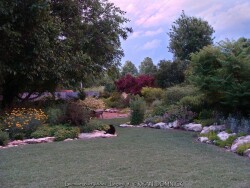

Tired of mowing and maintaining that water thirsty lawn? In our quest to be environmentally friendly and save water, we promote Legacy Buffalograss Lawns (Buchloe dactyloides 'Legacy'tm). Buffalograss has survived for millions of years, through droughts, floods and insect invasions. It is the only turfgrass that is native to the United States. Buffalograss has a very low water requirement and a deep root system that allows it to draw water from a large area. Buffalograss thrives on only 1/4 inch of water per week to stay green. Water savings with buffalograss is astounding. Over one million gallons of water can be saved on every turf acre every year by replacing a high water-use turfgrass, like bluegrass, with buffalograss. We feel the conservation of water is a must for all of us, but we must also reduce our dependency on excess chemicals and the need for the weekly ritual of mowing. Lawnmowers are one of the worst sources of air pollution we breath. Legacy buffalograss can be mowed only once every 2 to 3 weeks. Since this variety has such a short maximum height, many people choose to leave their lawns un-mowed at 4-6". ADVANTAGES OF LEGACY BUFFALO GRASS OVER OTHER LAWNS; 1. Buffalograss is the real "Green" lawn. It has environmental and economic traits that cannot be disputed. A typical homeowner will save hundreds of dollars a year on lawn maintenance costs. Large turf installations can save thousands of dollars. 2.Buffalograss requires much less mowing maintenance and in some situations, none. 3.Fewer weed problems occur; the dense growth of buffalo grass smothers out existing weeds and prevents the germination of new seeds. 4. Minimal lawn treatment program of only 3-5 visits is recommended (fescue & bluegrass lawns require 5-7 visits). 5. Buffalograss requires less water; and will survive with no supplemental irrigation. 6. Buffalograss has high wildlife value; it is native to the great plains of USA. 7. The soft texture and mint green color are great assets; its fun to walk on. 8. Buffalograss grows in zones 3-9; tolerates cold in the winter and heat in the summer. 8. Insect, disease and thatch build-up problems rarely occur in buffalograss lawns. 9. Buffalograss is tolerant of a wide range of soil types but prefers heavy clay. 10. Buffalograss can by divided by plugs to fill in damaged or new areas; can't be seeded. "SO WHY DOESN'T EVERYONE USE BUFFALOGRASS?" (DISADVANTAGES); 1.Buffalograss requires a higher upfront cost and more maintenance during the first year to get it established. Unfortunately, most people only consider the sticker shock of the initial cost. It takes 2-3 years for buffalo grass to pay for itself before savings occur. 2.Most landscape and lawn companies do not promote buffalo grass because they are in business to make money maintaining your lawn. Why would a lawn mowing company promote a lawn that doesn't need much mowing? Why would an irrigation company promote a lawn that didn't need an irrigation system? With few industry professionals promoting it, the true benefits remain unknown to the consumer. 3. Most landscape and lawn companies are not educated about buffalograss nor have the experience to successfully install, establish, and maintain buffalograss from plugs. 4. Buffalograss has a few limitations about where it will grow: it needs full sun, it will not grow in wet areas with poor drainage, and it needs a clay-based topsoil; no sand. 5. Buffalograss goes dormant sooner in late fall and greens up later in the spring.
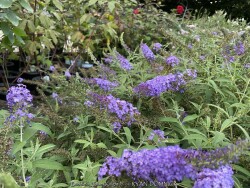

Butterfly Bush are workhorses in the pollinator garden. Flower panicles come in a variety of colors mostly including shades of lavender, magenta, violet, pink, and white. Most buddleia, (Butterfly Bush) bloom on new wood so trimming off winter kill or complete rejuvenation will not affect flowering. In fact, flowering is often bigger and bolder from new water sprout growth when trimmed to the ground each year. Most Butterfly Bushes in zone 6 are maintained this way. Foliage is typically an attractive greenish-gray to mint green and persists into the fall until hard freezes occur. Use in the landscape in small or large groupings for its amazing flower power! Plants grow best in full sun with medium to dry soils. Drought tolerance is high with established plants so extra watering is rarely needed in our East Kansas climate with 40 inches of rain per year. Obviously, Butterfly Bush attracts lots of butterflies. There has been some debate in recent years on whether to plant Butterfly Bush because it's a non-native plant. Being a native of China, it has no pest or disease problems here. It is invasive in some parts of the country but cold Kansas winters keep it and check and without any self-seeding problems here. If you are still worried about it, there are several sterile varieties to choose from. There have been many drastically improved cultivars in the last 10 years aiming to improve cold hardiness, bloom size, eliminate seeding, and improve growth habits. Buddleia 'Blue Knight' was developed by Walters Gardens, Inc. It is a new addition to the popular MONARCH® Butterfly Bush collection! 'Blue Knight' forms a dense clump of minty green leaves. Incredibly long, 10-12", outward-facing flower panicles open light lavender purple and deepen to blue-purple with age. The new and the aged flowers appear on the panicles at the same time, giving the flower an interesting two-tone effect. This plant has incredible flower coverage, giving you quite the performance when it starts its first flush of blooms in late summer. In Eastern Kansas, 'Blue Knight' has performs WELL for over 3 years with just about everything nature has to challenge it! Combine with caryopteris and crapemyrtle to create a late season "all you can eat" buffet for pollinators! The MONARCH® trademark is owned by Walters Gardens, Inc.
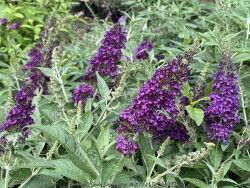

Butterfly Bush (Buddleia) are workhorses in the pollinator garden. Flower panicles come in a variety of colors mostly including shades of lavender, magenta, violet, pink, and white. Most Butterfly Bushes bloom on new wood so trimming off winter kill or complete rejuvenation will not affect flowering. In fact, flowering is often bigger and bolder from new water sprout growth when trimmed to the ground each year. Most Butterfly Bushes in zone 6 are maintained this way. Foliage is typically an attractive greenish-gray to mint green and persists into the fall until hard freezes occur. Use in the landscape in small or large groupings for its amazing flower power! Plants grow best in full sun with medium to dry soils. Drought tolerance is high with established plants so extra watering is rarely needed in our East Kansas climate with 40 inches of rain per year. Obviously, Butterfly Bush attracts lots of butterflies. There has been some debate in recent years on whether to plant Butterfly Bush because it's a non-native plant. Being a native of China, it has no pest or disease problems here. It is invasive in some parts of the country but cold Kansas winters keep it and check and without any self-seeding problems here. If you are still worried about it, there are several sterile varieties to choose from. There have been many drastically improved cultivars in the last 10 years aiming to improve cold hardiness, bloom size, eliminate seeding, and improve growth habits. Buddleia 'Dark Dynasty' is a compact new Buddleia fits easily into urban gardens with its densely compact, rounded habit. It is a new addition to the popular MONARCH® Butterfly Bush collection! Unlike some other dwarf Buddleias that become very wide spreading, 'Dark Dynasty' keeps its composure as it ages, growing just 3' tall and 3 ½' wide in two years. Rich royal purple, fragrant flowers are borne on branched panicles from late summer into early fall, just in time to feed the migrating monarchs passing through. In Eastern Kansas, 'Dark Dynasty' has performs WELL for over 3 years with just about everything nature has to challenge it! Combine with caryopteris and crapemyrtle to create a late season "all you can eat" buffet for pollinators! The MONARCH® trademark is owned by Walters Gardens, Inc.


Butterfly Bush (Buddleia) are workhorses in the pollinator garden. Flower panicles come in a variety of colors mostly including shades of lavender, magenta, violet, pink, and white. Most Butterfly Bushes bloom on new wood so trimming off winter kill or complete rejuvenation will not affect flowering. In fact, flowering is often bigger and bolder from new water sprout growth when trimmed to the ground each year. Most Butterfly Bushes in zone 6 are maintained this way. Foliage is typically an attractive greenish-gray to mint green and persists into the fall until hard freezes occur. Use in the landscape in small or large groupings for its amazing flower power! Plants grow best in full sun with medium to dry soils. Drought tolerance is high with established plants so extra watering is rarely needed in our East Kansas climate with 40 inches of rain per year. Obviously, Butterfly Bush attracts lots of butterflies. There has been some debate in recent years on whether to plant Butterfly Bush because it's a non-native plant. Being a native of China, it has no pest or disease problems here. It is invasive in some parts of the country but cold Kansas winters keep it and check and without any self-seeding problems here. If you are still worried about it, there are several sterile varieties to choose from. There have been many drastically improved cultivars in the last 10 years aiming to improve cold hardiness, bloom size, eliminate seeding, and improve growth habits. Buddleia 'Crown Jewels' was developed by Walters Gardens, Inc. It is a new addition to the popular MONARCH® Butterfly Bush collection! Grow this Butterfly Bush for its beautiful gold foliage which shines brightly from spring through fall, easily taking the place of a compact shrub in the landscape. As an added bonus, sharply contrasting, magenta purple flowers sparkle like jewels against the dense, golden foliage, pointing skyward on branched stems from late summer through early fall. Secondary flowers extend the show even further into fall. In Eastern Kansas, 'Crown Jewels' has performs WELL for over 3 years with just about everything nature has to challenge it! Combine with caryopteris and crapemyrtle to create a late season "all you can eat" buffet for pollinators! The MONARCH® trademark is owned by Walters Gardens, Inc.
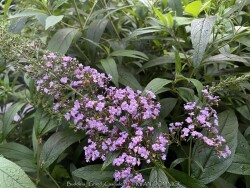

Butterfly Bush (Buddleia) are workhorses in the pollinator garden. Flower panicles come in a variety of colors mostly including shades of lavender, magenta, violet, pink, and white. Most Butterfly Bushes bloom on new wood so trimming off winter kill or complete rejuvenation will not affect flowering. In fact, flowering is often bigger and bolder from new water sprout growth when trimmed to the ground each year. Most Butterfly Bushes in zone 6 are maintained this way. Foliage is typically an attractive greenish-gray to mint green and persists into the fall until hard freezes occur. Use in the landscape in small or large groupings for its amazing flower power! Plants grow best in full sun with medium to dry soils. Drought tolerance is high with established plants so extra watering is rarely needed in our East Kansas climate with 40 inches of rain per year. Obviously, Butterfly Bush attracts lots of butterflies. There has been some debate in recent years on whether to plant Butterfly Bush because it's a non-native plant. Being a native of China, it has no pest or disease problems here. It is invasive in some parts of the country but cold Kansas winters keep it and check and without any self-seeding problems here. If you are still worried about it, there are several sterile varieties to choose from. There have been many drastically improved cultivars in the last 10 years aiming to improve cold hardiness, bloom size, eliminate seeding, and improve growth habits. Buddleia 'Grand Cascade' is an introduction by Walters Gardens, Inc. Unlike the typical Butterfly Bush, the panicles on this flowering shrub cascade downward, similar to the look of weeping willow or a bridalwreath spirea. Light lavender purple flower panicles are enormous at 12-14" long and 4" thick. They're nearly the size of your head! In Eastern Kansas, 'Grand Cascade' has performs WELL for over 3 years with just about everything nature has to challenge it! This is a larger Butterfly Bush growing to 5-6' but still dense and compact in appearance. Combine with caryopteris and crapemyrtle to create a late season "all you can eat" buffet for pollinators!
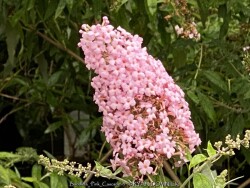

Butterfly Bush (Buddleia) are workhorses in the pollinator garden. Flower panicles come in a variety of colors mostly including shades of lavender, magenta, violet, pink, and white. Most Butterfly Bushes bloom on new wood so trimming off winter kill or complete rejuvenation will not affect flowering. In fact, flowering is often bigger and bolder from new water sprout growth when trimmed to the ground each year. Most Butterfly Bushes in zone 6 are maintained this way. Foliage is typically an attractive greenish-gray to mint green and persists into the fall until hard freezes occur. Use in the landscape in small or large groupings for its amazing flower power! Plants grow best in full sun with medium to dry soils. Drought tolerance is high with established plants so extra watering is rarely needed in our East Kansas climate with 40 inches of rain per year. Obviously, Butterfly Bush attracts lots of butterflies. There has been some debate in recent years on whether to plant Butterfly Bush because it's a non-native plant. Being a native of China, it has no pest or disease problems here. It is invasive in some parts of the country but cold Kansas winters keep it and check and without any self-seeding problems here. If you are still worried about it, there are several sterile varieties to choose from. There have been many drastically improved cultivars in the last 10 years aiming to improve cold hardiness, bloom size, eliminate seeding, and improve growth habits. Buddleia 'Pink Cascade' is an introduction by Walters Gardens, Inc. Unlike the typical Butterfly Bush, the panicles on this flowering shrub cascade downward, similar to the look of weeping willow or a bridalwreath spirea. Light apple blossom pink flower panicles are 8-10" long. Minty green leaves, in combination with the flowers, give it overall cool tones. Use as a focal piece in your garden or in the landscape. In Eastern Kansas, 'Pink Cascade' has performs WELL for over 3 years with just about everything nature has to challenge it! This is a larger Butterfly Bush growing to 5-6' but still dense and compact in appearance. Combine with caryopteris and crapemyrtle to create a late season "all you can eat" buffet for pollinators!


Butterfly Bush (Buddleia) are workhorses in the pollinator garden. Flower panicles come in a variety of colors mostly including shades of lavender, magenta, violet, pink, and white. Most Butterfly Bushes bloom on new wood so trimming off winter kill or complete rejuvenation will not affect flowering. In fact, flowering is often bigger and bolder from new water sprout growth when trimmed to the ground each year. Most Butterfly Bushes in zone 6 are maintained this way. Foliage is typically an attractive greenish-gray to mint green and persists into the fall until hard freezes occur. Use in the landscape in small or large groupings for its amazing flower power! Plants grow best in full sun with medium to dry soils. Drought tolerance is high with established plants so extra watering is rarely needed in our East Kansas climate with 40 inches of rain per year. Obviously, Butterfly Bush attracts lots of butterflies. There has been some debate in recent years on whether to plant Butterfly Bush because it's a non-native plant. Being a native of China, it has no pest or disease problems here. It is invasive in some parts of the country but cold Kansas winters keep it and check and without any self-seeding problems here. If you are still worried about it, there are several sterile varieties to choose from. There have been many drastically improved cultivars in the last 10 years aiming to improve cold hardiness, bloom size, eliminate seeding, and improve growth habits. Buddleia 'Queen of Hearts' is a compact new Buddleia fits easily into urban gardens with its densely compact, rounded habit. It is a new addition to the popular MONARCH® Butterfly Bush collection! The vibrant magenta red flowers of this new selection are sure to capture the hearts of gardeners everywhere, and the butterflies and hummingbirds will love them too! Large 7-9" long panicles are produced from the top of the plant to the bottom, pointing upward and outward on all sides in late summer and early fall. Smaller secondary flowers extend the show. In Eastern Kansas, 'Queen of Hearts' has performs WELL for over 3 years with just about everything nature has to challenge it! Combine with caryopteris and crapemyrtle to create a late season "all you can eat" buffet for pollinators! The MONARCH® trademark is owned by Walters Gardens, Inc.


Butterfly Bush (Buddleia) are workhorses in the pollinator garden. Flower panicles come in a variety of colors mostly including shades of lavender, magenta, violet, pink, and white. Most Butterfly Bushes bloom on new wood so trimming off winter kill or complete rejuvenation will not affect flowering. In fact, flowering is often bigger and bolder from new water sprout growth when trimmed to the ground each year. Most Butterfly Bushes in zone 6 are maintained this way. Foliage is typically an attractive greenish-gray to mint green and persists into the fall until hard freezes occur. Use in the landscape in small or large groupings for its amazing flower power! Plants grow best in full sun with medium to dry soils. Drought tolerance is high with established plants so extra watering is rarely needed in our East Kansas climate with 40 inches of rain per year. Obviously, Butterfly Bush attracts lots of butterflies. There has been some debate in recent years on whether to plant Butterfly Bush because it's a non-native plant. Being a native of China, it has no pest or disease problems here. It is invasive in some parts of the country but cold Kansas winters keep it and check and without any self-seeding problems here. If you are still worried about it, there are several sterile varieties to choose from. There have been many drastically improved cultivars in the last 10 years aiming to improve cold hardiness, bloom size, eliminate seeding, and improve growth habits.
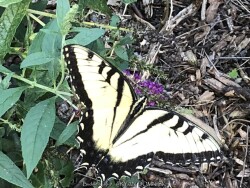

Butterfly Bush (Buddleia) are workhorses in the pollinator garden. Flower panicles come in a variety of colors mostly including shades of lavender, magenta, violet, pink, and white. Most Butterfly Bushes bloom on new wood so trimming off winter kill or complete rejuvenation will not affect flowering. In fact, flowering is often bigger and bolder from new water sprout growth when trimmed to the ground each year. Most Butterfly Bushes in zone 6 are maintained this way. Foliage is typically an attractive greenish-gray to mint green and persists into the fall until hard freezes occur. Use in the landscape in small or large groupings for its amazing flower power! Plants grow best in full sun with medium to dry soils. Drought tolerance is high with established plants so extra watering is rarely needed in our East Kansas climate with 40 inches of rain per year. Obviously, Butterfly Bush attracts lots of butterflies. There has been some debate in recent years on whether to plant Butterfly Bush because it's a non-native plant. Being a native of China, it has no pest or disease problems here. It is invasive in some parts of the country but cold Kansas winters keep it and check and without any self-seeding problems here. If you are still worried about it, there are several sterile varieties to choose from. There have been many drastically improved cultivars in the last 10 years aiming to improve cold hardiness, bloom size, eliminate seeding, and improve growth habits.